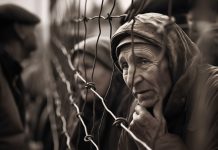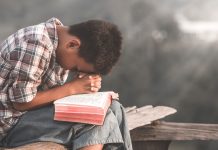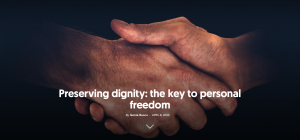Although the concept of human dignity may appear relatively recent from a historical perspective, the notion of human worth has a long history, as evidenced by accounts in the Book of Genesis, Cicero, and Kant, among others.[1]
However, defining this value has always been difficult and continues to be a challenge. What constitutes human dignity? Is it a noble and stable attitude, moral integrity, elevated status or existential status?
We may sometimes smile when contemporary artists emphasise their “worth” in their lyrics, remembering the Romanian adage about the smell of self-praise. So, what is this profound, nebulous dignity?
In order to answer this question, we will attempt a more existential and practical exploration.
In today’s vocabulary, the concept of dignity has contradictory meanings. Echoing the biblical example of Lamech, a descendant of Cain who was puffed up with importance and claimed more than was due to him, our age is witnessing a similar inflation of self-worth. This exaggerated focus on the self is a modern form of idolatry and manifests itself in a world where vanity is celebrated and superficiality often masquerades as efficiency. In such a landscape, the pursuit of authentic dignity becomes obscured, lost in the clamour for recognition and respect.
Against this backdrop of distorted values, we need authentic benchmarks. When we look for practical examples of dignity in people, exploring the lives of those who have historically been considered dignified is not only relevant, but necessary.
Escaping a dead end[2]
In 19th-century America, the dignity of slaves was not considered an inherent part of their humanity (which was generally considered inferior). In 1849, Araminta “Minty” Tubman prayed that God would intervene in the way her master treated them. Minty was born into a family of slaves in Maryland around 1820. Dignity was a privilege of her masters. She experienced the brutalities of slavery from an early age, including being employed as a nurse from a young age and suffering a life-changing head injury at 12 that left her with chronic ailments. However, these adversities only fuelled her determination. As her master showed no signs of changing despite her prayers, she began to pray for freedom from him. Shortly thereafter, her master died, causing uncertainty over the management of the plantation. Fearing for her life and family, Minty planned her escape to avoid being sold further south. She set out on a perilous journey to Pennsylvania via the Underground Railroad. This wasn’t just a flight to freedom, but the first step in a broader mission to liberate others. The first thing she did after gaining her freedom was to change her name to Harriet, in honour of her new status as a free woman. However, she felt that “freedom felt empty unless she could share it with people she loved”, so she returned to rescue her friends and family.
During her lifetime, Harriet was nicknamed “Moses” by the abolitionist William Lloyd Garrison, as she had led her people from slavery to freedom, much like Moses in the Bible.[3] Over the course of a decade, she led approximately 70 enslaved people to freedom, including her parents, and provided instructions that helped many others escape. Her strategic use of the Underground Railroad, a network of secret routes and safe houses, was marked by extraordinary courage and skill.
Her role expanded during the Civil War, when she served as a scout, spy, nurse and guerrilla agent for the Union Army, making use of her knowledge of Southern geography and society. After the war, she continued to support the cause, turning her attention to the issue of women’s suffrage and continuing her lifelong struggle for equality and justice.
In Babylon, with the harp
Less than a century later, a baby girl named Monica was born in Bucharest in 1923 into the family of Eugen Lovinescu and Ecaterina Bălăcioiu-Lovinescu. The wings of a dignified youth collided with the scourge of communism, leading her to seek political asylum in France in 1948. From 1951 to 1974, she worked on the Romanian-language programme at French Radio, and from 1962 she worked for Radio Free Europe. She presented two weekly programmes there which remain in the collective memory of contemporary Romanians: “Romanian Cultural News” and “Theses and Antitheses in Paris”. She established herself not only as an essayist and critic, but also as a beacon of free thought. Her work at Radio Free Europe made her a formidable opponent of the Romanian communist regime and resulted in an assassination attempt in 1977.
Later, after the Revolution, she reflected on her life in exile and published her diaries under the title La apa Vavilonului (By the rivers of Babylon). In conversation with Doina Jela, she explained the meaning behind the title of her diaries: “By the rivers of Babylon, I sat and wept. What image of exile is more biblical than this? Since I have spent most of my life in exile, the title came naturally to me. All the more so, as I endeavoured to contribute to the history of a phenomenon that was unknown to us on such a scale: the exile of thousands of Romanians, scattered across the waters of ‘Babylon’ for about half a century.”[4]
But what motivated her and her husband, Virgil Ierunca, to produce a weekly radio programme for those she had left behind? She could have enjoyed her freedom alone. Instead, she chose to send rays of light and keep the flame of hope alive. Her unwavering commitment to promoting freedom of expression and democratic ideals in the face of an oppressive regime illustrates her deep respect for the intrinsic value of each individual. By giving a voice to those who had been silenced, and by upholding the principles of intellectual freedom, Monica Lovinescu’s actions, while not literally freeing people from the oppressive regime, fuelled hope and cultivated the courage to yearn for freedom. They also reaffirmed the inherent human dignity that had been oppressed by the communist regime. These were the notes of her harp on the banks of Babylon. Her life demonstrates that dignity is not only an inherent right, but also something that must be actively defended and promoted, particularly in environments where it is under threat.
At school, amid bullets
Much closer to the present day, Malala Yousafzai speaks to us about dignity, showing us another of its aspects: the right to knowledge and self-determination, regardless of gender. Born in Pakistan in 1997, Malala is renowned for her opposition to the Taliban’s prohibition of girls’ education. Her courage in speaking out for a girl’s right to education resulted in an attempt on her life when she was only 15 years old. She survived and continued her work to promote the right to education for all, becoming the youngest Nobel Peace Prize laureate in 2014.
In her speech to the United Nations General Assembly on 12 June 2013, Malala Yousafzai reaffirmed her commitment to the cause of education, particularly for girls: “I speak not for myself, but for all girls and boys. I raise up my voice—not so that I can shout, but so that those without a voice can be heard. Those who have fought for their rights: Their right to live in peace. Their right to be treated with dignity. Their right to equality of opportunity. Their right to be educated.”
Malala’s story is not only about personal courage, but also about the power of education to empower individuals and societies. It serves as a reminder of the ongoing struggle for gender equality and the right to education. Her words reflect her unwavering commitment to promoting and ensuring educational opportunities for all, particularly girls, and her belief in education’s transformative power to create a more equitable world.
The dignity of a life lived
What gives these people their dignity? It is their unwavering resilience and selfless dedication to serving others; their courage and perseverance; their integrity; and their impact. Through their tireless resistance and selfless commitment, these individuals have upheld the fundamental freedom of conscience and its expression. They have also highlighted the essential role of moral conscience in defining our humanity. Created in the image of God from the beginning, humanity fell into moral bankruptcy, transforming the dignity bestowed upon it through creation into a grotesque form of self-idolatry. However, the sacrificial life and death of Jesus Christ offers us a way to regain our status as children of God and our practical awareness of this fact. When people contemplate consistently on this supreme act, through which human dignity was restored as an aspiration and a reality, their lives become ones of service, reaffirming the inherent dignity of human beings—the life of another is worth sacrificing my own.
On the cross, when faced with the temptation to prioritise Himself over others, Jesus chose humanity. Christ’s act of self-sacrifice embodies God’s character and is a gift of life to humanity. When people imitate this selfless devotion, as Jesus did for the world, they reflect a fragment of that supreme dignity upon themselves and others. Therefore, those who reflect God’s character do not consider themselves more worthy than others, and those who follow God steadfastly use their conscience to serve their neighbours. In this way, something of the dignity with which we were endowed at creation is restored.
Laurenţiu Nistor analyses the concept of human dignity through the lens of historical and contemporary figures, illustrating how our daily values and actions can affirm or undermine this essential ideal.
















